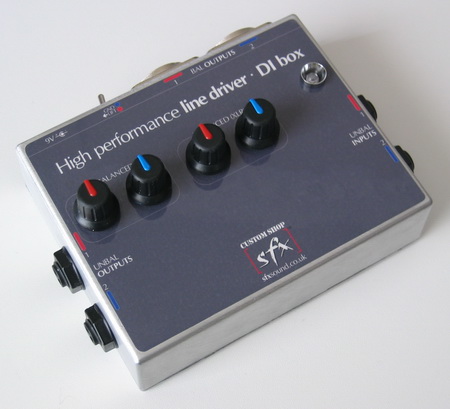


I don't use an amplifier with my main pedal board of effect pedals. I either use line level stereo monitors, or a mixer plugged into whatever sound reinforcement is appropriate or headphones.
Before I wised up I plugged my FX chain directly into my mixer, then I had to turn the faders right up, but this resulted in a lackluster sound with a lot of background noise, not much fun.
Over a period of time through private discussion Max Greco helped me understand why I was experiencing hiss and noise issues with my setup and explained the difference between instrument level and line level signals, then explained the role of a line booster. Once I understood the implications, Max offered to build me a custom line driver. At my request he happily included XLR balanced stereo ouputs and 1/4" unbalanced stereo outputs each with a seperate volume control and ground lift.
From that point on Max's communication was exemplary. He kept me abreast of design progress, when decisions were needed he quickly informed me of my options, made sure I understood the reasons, sent clear diagrams and gave his own recommendations. I trusted his experience most of the time and glad I did.
I was surprised how short a time it took from the time we had a final design to it's completion. From there Max had it on my doorstep within a couple of weeks, from UK to NZ.
Due to Max's recommendations the controls are easy to understand and access. I'm really happy how transparent & clean it is. It gives a clean signal for the mixer making my rig sound really good, loud but without all the noise I'd been battling with before. Once I'm playing I forget it's there, which is great.
[sfx] is a professional business that pays attention to detail, makes the customer's requirements a priority, and maintains good communication throughout the process.
- Greg Dyer, Wellington (New Zealand)
Greg is an harmonica player well known within the harmonica community. His web site: Harp On! CHR is a reference point in study of the Chromatic Harmonica.
Greg uses a fairly complex rig that includes several pedals and a preamplifier. He uses his rig for recording, practice and eventually for live performances.
From our early discussions it clearly appeared that his problems with noise and lack of sound definition were due to signal levels and impedance mismatch.
We agreed that the best solution for his problem was a dedicated stereo line driver with independent balanced and unbalanced outputs.
The requirements I set for the technical design were:
 Stereo unit Stereo unit | Greg uses stereo processing as part of his sound and it was very important to achieve good channel separation. |
 Clarity Clarity | The last thing I wanted is give Greg a unit that didn't make 100% happy. I paid particular attention to impedance and gain control to guarantee maximum clarity independently from the gain setting. |
 Headroom Headroom | I knew the exact characteristics of the signals in Greg's rig so the unit needed to be able to manage virtually any signal Greg could throw at it. |
 Intuitive interface Intuitive interface | The unit can be used in different environments: from studio to live performance. It was important that the box was usable "without thinking". |
 Long cable driving Long cable driving | Greg needed to use the box to drive cables that could be unusually long for a DI box. If the cable capacitance rises above a certain level, standard line drivers may start to oscillate. The design needed to take this into consideration. |
The design uses separate circuits for the two channels with no point of contact between the two signal paths for maximum signal separation.
The unit is powered by a standard 9V DC connector but the internal rail-to-rail voltage is >30V. It virtually never clips. The knobs control the internal gain of the unit instead of the output levels. In this way the unit operates always at its best.
The device uses colour coding and logical position for the connection in order to make connectivity and control simple and intuitive.
The output drivers use internal compensation to eliminate oscillations instability even under the most demanding conditions.
We also included electrostatic protection for both inputs as Greg mentioned that he experienced problems related to electrostatic charges with some of his devices.
It was a real pleasure dealing with Greg. He is an experienced musician with clear ideas about the sound the wants and the level of quality he expects. We hope the device we designed for him will be part of his sound for years to come.
- Max Greco [sfx]